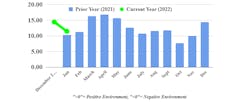Trucking conditions opened year strong, but Ukraine war increases operating risks
FTR’s Trucking Conditions Index fell to 11.46 from 14.45 between December 2021 and January amid rising diesel prices, the transportation intelligence firm reported on March 14. While higher freight rates were able to limit diesel’s effect on trucking operations to start the year, the problem has grown worse since Russia invaded Ukraine and could affect smaller fleets more, FTR’s analysts warned.
Although the more robust freight rates at the start of 2022 more than offset the effects of higher fuel costs, freight volume was a significantly weaker factor than it had been in December, according to the TCI, which was published in FTR’s March Trucking Update.
Since the year began, fuel costs have surged in the wake of Russia’s war in Ukraine. Those rising costs—diesel’s price per gallon set a U.S. record in March—will hurt trucking conditions in the near term, according to FTR analysis. But the longer-term effects of geopolitical tensions in Eastern Europe are not yet clear, according to Avery Vise, FTR's VP of trucking.
For now, the latest TCI outlook remains positive, but the downside risks have increased greatly.
“The war in Ukraine has introduced a high level of uncertainty into the dynamics of truck freight,” Vise said. “Sharply higher fuel costs for carriers are a given, but we do not yet know whether sharply higher gasoline prices on top of strong pre-existing consumer inflation and big swings in the stock market will lead to a drop in consumer spending.”
Vise said the rising operation costs could impact the newest trucking fleets in the U.S. Since mid-2020, tens of thousands of smaller for-hire carriers were established, most consisting of fewer than 10 vehicles.
“Many will fail, but whether that outcome strengthens or weakens today’s rate leverage for carriers depends greatly on whether failing carriers’ drivers quit the industry or return to driving positions for larger carriers,” Vise explained. “We generally would presume the latter, which could relieve some rate pressure, but the labor market has changed too much during the pandemic to make that a sure bet.”
The TCI tracks the changes representing five major conditions in the U.S. truck market: freight volumes, freight rates, fleet capacity, fuel price, and financing. The individual metrics are combined into a single index indicating the industry’s overall health.
A positive TCI score represents good, optimistic conditions. Conversely, a negative score represents bad, pessimistic conditions. Readings near zero are consistent with a neutral operating environment, and double-digit readings in either direction suggest significant operating changes are likely.
Along with the latest TCI report and commentary on freight demand risks in the wake of sharp retail inventory gains this year, FTR’s Trucking Update includes data and analysis on load volumes, the capacity environment, rates, and the economy.

